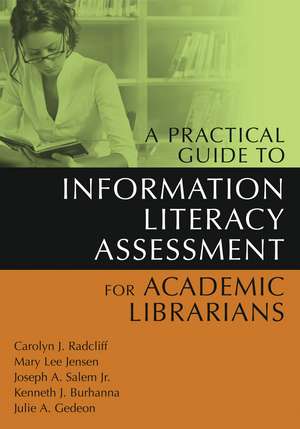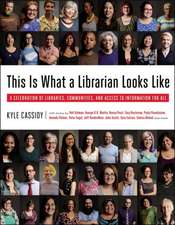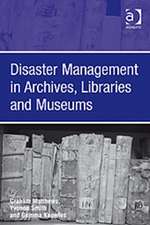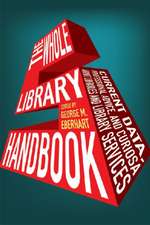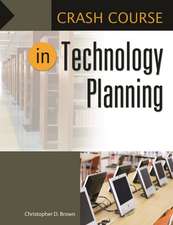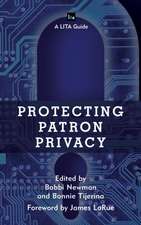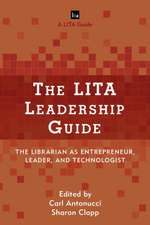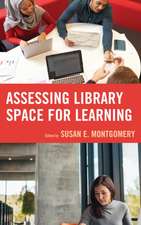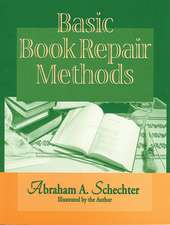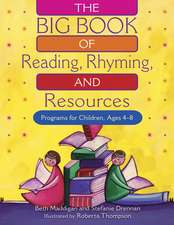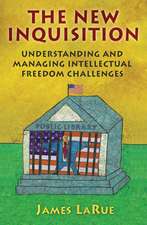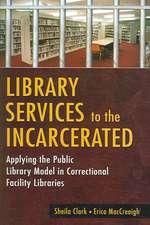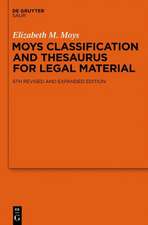A Practical Guide to Information Literacy Assessment for Academic Librarians
Autor Carolyn Radcliff, Mary L. Jensen, Joseph A. Salem, Jr., Kenneth J. Burhanna, Julie A. Gedeonen Limba Engleză Paperback – 29 iun 2007 – vârsta până la 17 ani
Preț: 265.17 lei
Preț vechi: 321.88 lei
-18% Nou
Puncte Express: 398
Preț estimativ în valută:
50.75€ • 52.84$ • 42.89£
50.75€ • 52.84$ • 42.89£
Carte tipărită la comandă
Livrare economică 11-25 martie
Preluare comenzi: 021 569.72.76
Specificații
ISBN-13: 9781591583400
ISBN-10: 1591583403
Pagini: 196
Dimensiuni: 178 x 254 x 13 mm
Greutate: 0.41 kg
Editura: Bloomsbury Publishing
Colecția Libraries Unlimited
Locul publicării:New York, United States
ISBN-10: 1591583403
Pagini: 196
Dimensiuni: 178 x 254 x 13 mm
Greutate: 0.41 kg
Editura: Bloomsbury Publishing
Colecția Libraries Unlimited
Locul publicării:New York, United States
Notă biografică
Carolyn J. Radcliff is Associate Professor in Libraries and Media Services and Reference and Instruction Librarian at Kent State University.Mary Lee Jensen is Assistant Professor in Libraries and Media Services and Head of Instructional Services at Kent State University.Joseph A. Salem, Jr.. is Assistant Professor in Libraries and Media Services and Head of Reference and Government Information Services at Kent State University.Kenneth J. Burhanna is Assistant Professor in Libraries and Media Services and First Year Experience Librarian at Kent State University.Julie A. Gedeon is a Coordinator of Library Assessment for Libraries and Media Services at Kent State University.
Cuprins
AcknowledgmentsChapter 1: IntroductionPart I: Getting StartedChapter 2: A Brief Look at AssessmentChapter 3: How to Choose the Right Assessment ToolPart II: The ToolsChapter 4: Informal Assessment TechniquesChapter 5: Classroom Assessment TechniquesChapter 6: SurveysChapter 7: InterviewingChapter 8: Focus GroupsChapter 9: Knowledge TestsChapter 10: Concept MapsChapter 11: Performance and Product AssessmentsChapter 12: PortfoliosPart III: What to Do with the InformationChapter 13: Analyzing the DataChapter 14: Working with the ResultsIndex
Recenzii
Throughout this guide, the authors cover formal and informal assessment techniques for use both in and outside of the classroom. Works cited and suggestions for futher reading abound. Overall, this book is an excellent guide and should be required reading for all librarians implementing information literacy at their institution.
Written for academic library practitioners and administrators, this work provides advice for those who wish to determine the information literacy levels of students, whether for an entire institution, a single instructional session, and something in between. The authors (all of Kent State U.) describe the key characteristics, definitions, required resources, and processes of different assessment tools, including surveys, interviewing, focus groups, knowledge tests, concept maps, performance assessments, and portfolios. They also describe how to analyze collected data and apply results.
By arming librarians with knowledge of the core information literacy assessment tools, the authors make significant strides in advancing information literacy assessment. As an instructional text, the guide is clearly structured and eminently readable, and both beginning and veteran librarians will find this resource accessible, either as a cover-to-cover read or as a scan able handbook. Consequently, the work is a valuable resource and complement to the journal literature in the area of information literacy assessment.
Assessment is an important topic for all academic libraries and one that can be challenging to both understand and to implement. This book does that and more in an immensely well-written and accessible guide to the subject of assessment for academic librarians.This is an essential title for every academic library engaged in information literacy instruction. Its comprehensive yet easy-to-understand presentation will guide both the uninitiated and the experienced librarian in choosing and implementing appropriate assessment measures.
A consistent strength of this book is the clear layout, with the use of icons for key indicators such as time, money, level, domain and access to participants, degreee of academic collaboration and the need for outside expertise. . . . A secondary benefit is the comprehensive way each theme is addressed with sections, which could be used to help social research enquirers who are concerned about methodology. The clarity of the text is enhanced by diagrams and tables and figures.
Written for academic library practitioners and administrators, this work provides advice for those who wish to determine the information literacy levels of students, whether for an entire institution, a single instructional session, and something in between. The authors (all of Kent State U.) describe the key characteristics, definitions, required resources, and processes of different assessment tools, including surveys, interviewing, focus groups, knowledge tests, concept maps, performance assessments, and portfolios. They also describe how to analyze collected data and apply results.
By arming librarians with knowledge of the core information literacy assessment tools, the authors make significant strides in advancing information literacy assessment. As an instructional text, the guide is clearly structured and eminently readable, and both beginning and veteran librarians will find this resource accessible, either as a cover-to-cover read or as a scan able handbook. Consequently, the work is a valuable resource and complement to the journal literature in the area of information literacy assessment.
Assessment is an important topic for all academic libraries and one that can be challenging to both understand and to implement. This book does that and more in an immensely well-written and accessible guide to the subject of assessment for academic librarians.This is an essential title for every academic library engaged in information literacy instruction. Its comprehensive yet easy-to-understand presentation will guide both the uninitiated and the experienced librarian in choosing and implementing appropriate assessment measures.
A consistent strength of this book is the clear layout, with the use of icons for key indicators such as time, money, level, domain and access to participants, degreee of academic collaboration and the need for outside expertise. . . . A secondary benefit is the comprehensive way each theme is addressed with sections, which could be used to help social research enquirers who are concerned about methodology. The clarity of the text is enhanced by diagrams and tables and figures.
